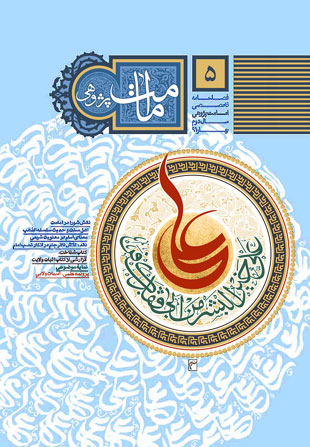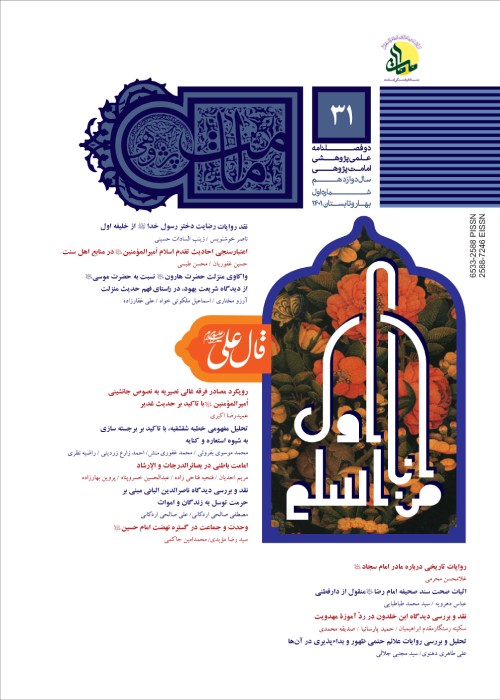فهرست مطالب

نشریه امامت پژوهی
پیاپی 5 (بهار 1391)
- 400 صفحه، بهای روی جلد: 40,000ريال
- تاریخ انتشار: 1391/09/01
- تعداد عناوین: 14
-
صفحه 2
- مقالات
-
صفحه 9پیرامون امامت حضرت علی علیه السلام و دیگر امامان علیهم السلام، دو دیدگاه وجود دارد: یکی اثبات امامت از طریق بیعت و دیگری اثبات امامت از طریق شورا. در نوشتار حاضر، نویسنده در راستای تبیین نقش شورا در امر امامت، مباحث خود را در سه محور ارائه می کند: 1 خدای سبحان و تعیین امام؛ 2 بررسی خلافت و امامت ابوبکر و عمر؛ 3 زمان طرح نظریه شورا. نگارنده با تبیین این سه محور، به بیان دلیل و مدرک نظریه شورا در کتاب خدا و سنت و سیره رسول گرامی اسلام صلی الله علیه وآله وسلم می پردازد.
کلیدواژگان: شورا، امام، امامت، خلافت، قرآن کریم، پیامبر اکرم (ص) -
صفحه 35حدیث «سلسله الذهب» منقول از امام رضا علیه السلام در جریان ورود تاریخی آن حضرت به نیشابور در منابع شیعی با دلالت «حصن» نقل شده و از جایگاه و اعتبار ویژه ای نیز برخوردار است. اما این حدیث در منابع اهل سنت، گاه با دلالت «حصن» و گاه با دلالت «ایمان» نقل شده است که این امر، حاصل نگاه اهل سنت به حدیث «سلسله الذهب» است. این مقاله می کوشد با رویکردی توصیفی تحلیلی به اسانید وطریق های حدیث «سلسله الذهب» در منابع اهل سنت و نیز دو نگاه متفاوت آنان به این حدیث، چهره واقع بینانه ای از نگاه اهل سنت به این حدیث شریف را ترسیم نماید. همچنین با نقد نگاهی که حدیث را منحصر در اباصلت هروی می داند، دو فرضیه تواتر حدیث سلسله الذهب و مستفیض بودن آن با دلالت حصن نزد اهل سنت با تکیه بر منابع آنها و نقل بدون واسطه اثبات می شود.
کلیدواژگان: سلسله الذهب، اهل سنت، حصن، ایمان، اباصلت هروی، موافقین، مخالفین -
صفحه 75
- پرونده علمی: (ادبیات ولایی)
-
صفحه 101
-
صفحه 125در گنجینه گهربار اما ناشناخته ادب فارسی، حماسه های دینی که به دلاوری های مولای متقیان علی علیه السلام پرداخته اند، فراوان ند که بسیاری از آن ها با نام عام «حمله حیدری» سروده و تدوین شده اند. در این مقال به معرفی منظومه «غزوات» اثر میرزا ابوطالب فندرسکی پرداخته ایم.
در معرفی این منظومه دو نکته قابل ذکر است: اول آنکه تا قبل از تصحیح این اثر، همه ادب پژوهان آن را با عنوان«تکمله حمله حیدری» اثر «باذل مشهدی» می شناختند؛ حال آنکه اثری مستقل بوده که سال ها قبل از حمله حیدری سروده شده است. نکته دوم، اهمیت اثر از جهت تاریخی است؛ صحت و انطباق مطالب آن با منابع معتبر تاریخی، کم نظیر بلکه بی نظیر است و به همین دلیل با بسیاری از حماسه های دینی که به افسانه و خرافه گرایش دارند، تفاوت دارد.
کلیدواژگان: منظومه، غزوات، شعر، منظومه غزوات، حماسه دینی، امام علی علیه السلام، میرزا ابوطالب فندرسکی، عصر صفویه -
صفحه 151این مقاله، شعر آیینی را چنانکه میان شعرای معاصر مرسوم است به مدایح و مراثی خاندان وحی مختص می داند و توحیدیه ها، مناجات ها و... از موضوع این نوشتار خارجند.
براساس پژوهش انجام شده، شعر آیینی فارسی که سابقه ای به قدمت شعر فارسی دارد، در سالهای پس از پیروزی انقلاب اسلامی روندی رو به رشد داشته است. شعر آیینی تا پیش از دوران مورد بررسی، غالبا به مضامین عاشورایی محدود بود و کمتر به دیگر مضامین آیینی می پرداخت؛ اما در دوران مورد بررسی که سالهای 1357 تا 1390ش را در برمی گیرد درمورد چهره های آیینی مختلف شعر سروده شد و شاعران آیینی سرا فصول جداگانه ای به هریک از معصومان و چهره های آیینی شیعی اختصاص دادند. در دهه سوم مورد بررسی، گونه ای از آیینی سرایی با رویکرد عرفانی شکل گرفت که مورد استقبال گسترده مخاطبان قرار گرفت. جریان دیگری که در سالهای پایانی دوران مورد بررسی در اشعار آیینی دیده شده، بهره گیری از طنز است که به صورت چشم گیری در حال گسترش است. گونه زبانی اخیر شاید به دلیل بی سابقه یا کم سابقه بودن آن، مورد توجه و علاقه بخش قابل توجهی از مخاطبان قرارگرفته است.
کلیدواژگان: شعر آیینی، شعر معاصر ایران، شاعران آیینی، شعر آیینی دوره انقلاب اسلامی -
صفحه 179این جستار، ابتدا استحکام کلام میرزا حبیب خراسانی را در سطوح مختلف زبان و ادبیات می سنجد و سپس به مضامین شعری او می پردازد. با توجه به مرجعیت دینی میرزا حبیب، تعداد اشعار مذهبی وی نسبت به اشعار متفرقه کمتر از حد انتظار است. شادی در شعر او به طرز معناداری محسوس است و مرثیه در شعر او جایی ندارد. همچنین به راه و رسم عارفان و حتی شدیدتر از بسیاری از آنان به ظواهر شرع تاخته است؛ امری که درباره یک مرجع تقلید شگفت می نماید. در این پژوهش بیشتر به این موارد پرداخته شده است: شاخصه های پایبندی به شریعت، سرسپردگی به عرفان، میزان دغدغه های اجتماعی و نوع نگاه شاعر به مدیحه پردازی دینی.
کلیدواژگان: نقد ادبی، میرزا حبیب خراسانی، شعر منقبتی، شعر عصر قاجار، شعر عرفانی -
صفحه 211
- نقد اندیشه
- کتاب شناخت
-
صفحه 289
-
Page 9Concerning Imamah of ‘Ali (PBUH) and other Imams (PBUT), there are two views: first, their Imamah is proved through [the principle of] Imamah and in the other it is proved through [the principle of] Shura. In the present writing, to explain the role played by Shura in Imamah, the author introduces his points under three categories: 1 God the Glorified and appointment of Imam; 2 Study of Caliphate and Imamah of Abu Bakr and ‘Umar; and 3 the time of introduction of Shura theory. Explaining these three categories, the author goes to provide pieces of evidence for the theory of Shura from the Holy Quran and the Holy Prophet’s tradition.Keywords: Shura, Imam, Imamah, Imamah, Caliphate, the Holy Quran, the Holy Prophet
-
Page 35The hadith with golden chain quoted by Imam Rida (PBUH) on his historical entrance to Nishapur has been narrated by Shi’i sources under “husn” (fort) and is of paramount importance. In Sunni sources, however, this hadith has been sometimes quoted under “husn” and some other times under “iman” (faith) and this is a result of the Sunni’s look at the hadith with golden chain. Adopting a descriptive analytic approach to chains of transmitters of this hadith in Sunni sources and their two different views to this hadith, the present writing tries to depict a realistic picture of Sunni’s look at this noble hadith. Also, criticizing the view according to which narration of hadiths is restricted to what that has been done by Aba Salt Hirawi and relying upon their sources and immediate quotations from such sources, the author tries to prove two hypotheses of frequency of the hadith and that it covers the entry “husn” according to Sunnis.Keywords: hadith with golden chain, Sunnis, Husn, faith, Aba Salt Hirawi, proponents, opponents
-
Page 125In the valuable but unknown treasure of Persian literature, there are many religious epics in which bravery of the Commander of the Faithful, ‘Ali (PBUH), has been spoken of and many of them have been composed as “Combats of the Lion1”. In this writing, we introduce the epopee of Ghazawat composed by Mirza Abu Talib Findiriski. To introduce this epopee, two points should be noted: first, when this epopee had not been yet edited, all literary scholars thought that it was a “supplement to Combats of the Lion” composed by “Badhil Mashhadi; while it is an independent work composed many years before “Combats of the Lion”. Second, this work is of historical importance and it is, in terms of correspondence to historical authentic sources, unique and for the same reason it is different from many religious epics which are near to myths and superstitions.Keywords: Epopee of Ghazawat, religious epic, Imam Ali (PBUH), Mirza Abu Talib Findiriski, Safavi Age
-
Page 151Just in the same way that the contemporary poets think, the present article considers only elegies and panegyrics composed for the Household of Revelation as ritual poetry; and tawhid poetry and liturgies are out of the scope of the present writing. According to the studies made, Persian ritual poetry, which is as old as Persian poetry, has been growing in years after the Islamic Revolution. Before these years, ritual poetry was mostly limited to the themes taken from Ashura epic and other ritual themes were not so touched. In the years under study (1390 1357 / 2011 1978) poems were composed concerning various ritual figures and ritual poets devoted independent chapters to the Infallibles (PBUT) and Shi’i ritual figures. In the third decade, a genre of ritual poetry emerged in which a mystical approach was adopted. This genre was warmly welcomed by the audience. The other genre which has been seen in the ending years of the above period is employment of humor which is strikingly expanding. Perhaps since it is unprecedented or rare, this linguistic genre has drawn interest of a considerable part of the addressees.Keywords: ritual poetry, Persian contemporary poetry, ritual poets, ritual poetry in the age of Islamic Revolution
-
Page 179At first, the present essay evaluates Mirza Habib Khurasani’s strength of words at various linguistic and literary levels; then, it goes to discuss his poetic themes. Mirza Habib was a religious leader and so number of his religious poems is, as compared to other kinds of poetry, less than what that is expected. Happiness may be significantly felt in his poetry and there is no room in his poetry for elegy. Also, in the way of mystics and even more severe than many of them he has attacked the religious appearances, and this is wonderful when done by a religious leader. In the present study, mostly the following points have been discussed: signs of commitment to religious law (shari’ah), interest in mystics, social concerns and the poet’s look at religious panegyrics.Keywords: literary critique, Mirza Habib Khurasani, poetry in Qajar Age, mystical poetry
-
Page 211Azeri speaking poets may be considered as the most ardent ones working in the field of wala’i literature. The present writing is a report of the poetry of Azeri speaking ritual poets written by Mr. ‘Isa Thaqib Bakhshayesh (one of the Azeri speaking poets and panegyrists). At first, he describes how Azeri speaking people hold mourning ceremonies for the Household (PBUT) and then he introduces ceremonies such as “putting a washbasin”, “king Husayn” and the like. Concerning each of the above ceremonies, he mentions an example of poems and liturgies. Referring to Azeri poems, in what follows he describes what that characterizes Azeri speaking people in holding mourning ceremonies for the Household (PBUT). Finally, the author concludes with classification of liturgies composed by Azeri speaking liturgists in terms of the tone of their words (and quotes examples in this regard), and introduces some poets, publishers, and poetic forms of the ritual poetry.Keywords: Azeri liturgy, Azeri speaking poets, walai literature, ritual ceremonies, Azeri speaking liturgists, ritual literature
-
Page 257The present article studies and analyzes one of the conspiracies made by the opponents to alter the message of Ghadir. To do this, at first, the author studies the event of Ghadir and its relation to the principle of Imamah as viewed by Saudi Wahhabism. Then, referring to some sources for his point, he enlists alterations made in this concern. In what follows, he quotes from Haydar ‘Ali Qalamdaran’s Shahrah i ittihad (Expressway to Unity) as an example of alterations of the message of Ghadir) and influence of Yemen suspicion on it. He concludes his article with an analysis of alterations made by Haydar ‘Ali Qalamdaran.Keywords: alteration of the message of Ghadir_rejection of appointment of Imam_Imamah of Ali (PBUH)_Yemen Suspicion_Haydar Ali Qalamdaran_Shahrah i ittihad


